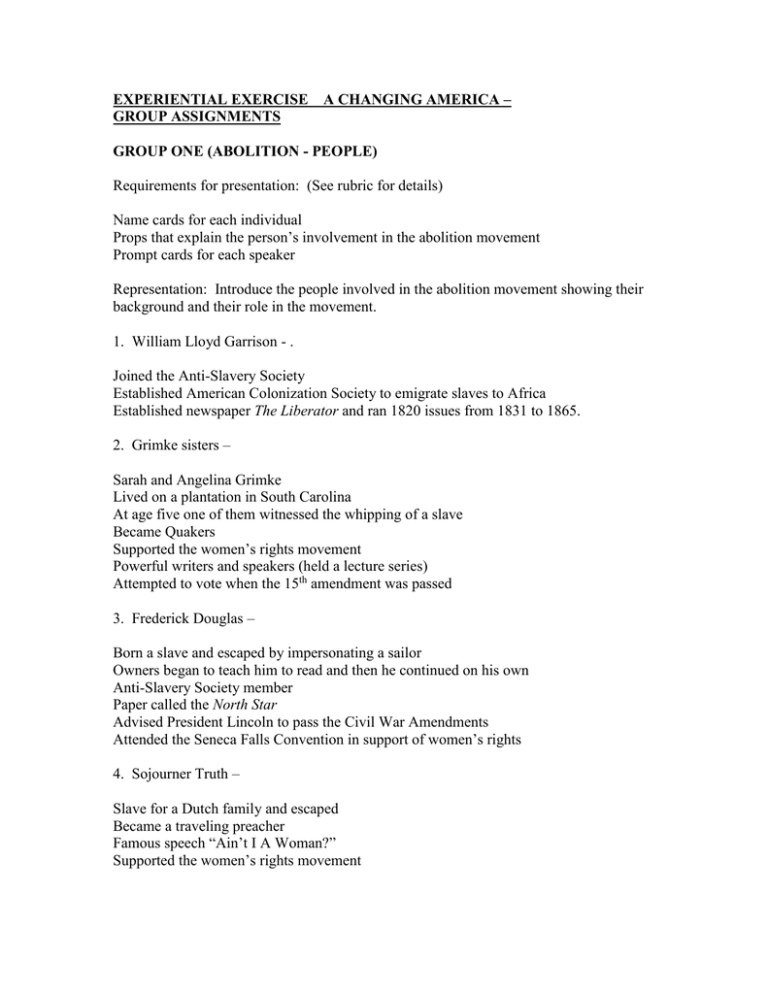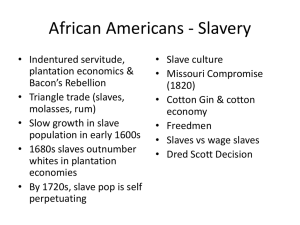Experiential Exercise
advertisement

EXPERIENTIAL EXERCISE GROUP ASSIGNMENTS A CHANGING AMERICA – GROUP ONE (ABOLITION - PEOPLE) Requirements for presentation: (See rubric for details) Name cards for each individual Props that explain the person’s involvement in the abolition movement Prompt cards for each speaker Representation: Introduce the people involved in the abolition movement showing their background and their role in the movement. 1. William Lloyd Garrison - . Joined the Anti-Slavery Society Established American Colonization Society to emigrate slaves to Africa Established newspaper The Liberator and ran 1820 issues from 1831 to 1865. 2. Grimke sisters – Sarah and Angelina Grimke Lived on a plantation in South Carolina At age five one of them witnessed the whipping of a slave Became Quakers Supported the women’s rights movement Powerful writers and speakers (held a lecture series) Attempted to vote when the 15th amendment was passed 3. Frederick Douglas – Born a slave and escaped by impersonating a sailor Owners began to teach him to read and then he continued on his own Anti-Slavery Society member Paper called the North Star Advised President Lincoln to pass the Civil War Amendments Attended the Seneca Falls Convention in support of women’s rights 4. Sojourner Truth – Slave for a Dutch family and escaped Became a traveling preacher Famous speech “Ain’t I A Woman?” Supported the women’s rights movement 5. Benjamin Lundy – Anti-Slavery Society member Lectured against slavery Worked with William Lloyd Garrison Quaker . GROUP TWO (ABOLITION – UNDERGROUND RAILROAD) Requirements for presentation: (See rubric for details) Name cards for each individual Props that explain each part of the Underground Railroad movement Prompt cards for each speaker Representation: Show the process the slaves followed from plantation to Canada and then the process from plantation to being caught and returned to the plantation. 1. The Underground Railroad was a network that carried runaway slaves to Canada. There were over 100,000 slaves that used this network. The slaves would start on the plantations with some escaping themselves and others having people come to escort them to the network. Each place the slaves would stay were called stations or depots. The people that helped them at these stations were called station masters or conductors. 2. Harriet Tubman was a runaway slave that became a leader in the abolition movement. She actively went to plantations to help slaves to the network. During the Civil War She served as both a nurse and as a spy for the federal forces in South Carolina. 3. The Fugitive Slave Law (Act) of 1850 – The law mandated the return of runaway slaves. GROUP THREE (REFORM – EDUCATION) Requirements for presentation: (see rubric for details) Name cards for each individual Props that explain each part of the Underground Railroad movement Prompt cards for each speaker Representation: Show the establishment of the three areas of education and what they offered the public. 1. Horace Mann Established public education in Massachusetts Father of American public education Created the single school system in Massachusetts that spread across America “Education then, beyond all the devices of human origin, is the great equalizer.” 2. Thomas Howe Established school for blind people He developed Boston Line Type that was raised letter printing Barbier originally developed a code for sending message without light that was raised dots Braille was a Frenchman who was blind and modified the use of this code to develop braille 3. Thomas Gallaudet Established school for deaf people in Connecticut He traveled to Europe and brought back a sign language instructor GROUP FOUR (REFORM – WOMEN’S RIGHTS) Requirements for presentation: (see rubric for details) Name cards for each individual Props that explain each part of the women’s rights movement Prompt cards for each speaker Representation: Your presentation should show the individuals involved in the movement, the reasons for the movement, a definition for those that worked in the movement, and the convention being held with specific reference to the Declaration of Sentiments. : 1. Name of suffragettes Susan B. Anthony, Lucy Stone, Elizabeth Cady Stanton, Lucretia Mott 2. Abigail Adams as part of the women’s rights movement, but much earlier in history (John Adams and Declaration of Independence) 3. Sojourner Truth as a part of the women’s rights movement AND the abolition movement 4. The rights they wanted: married women own property, education, and voting 5. A definition of suffrage and suffragettes. 6. The Seneca Falls Convention and the Declaration of Sentiments . GROUP FIVE (REFORM – TEMPERANCE MOVEMENT) Requirements for presentation: (see rubric for details) Name cards for each individual Props that explain each part of the temperance movement Prompt cards for each speaker Representation: The creation of a group of women protesting men drinking in a saloon. 1. Doors to a saloon. 2. Women outside of saloon singing and handing out pamphlets 3. Large pamphlet showing what happens as a result of the men’s drinking. GROUP SIX (LITERATURE) Requirements for presentation: (see rubric for details) Name cards for each individual Props that explain the books and the topics in the books Prompt cards for each speaker Representation: A look at various authors and their writings and the fact that these writings now have an emphasis on America. 1. The authors, titles, and subject matter of the books. Washington Irving Rip Van Winkle Legend of Sleepy Hollow James Fennimore Cooper Last of the Mohicans The Deerslayer Henry Wadsworth Longfellow Paul Revere’ Ride Song of Hiawatha Nathaniel Hawthorne Scarlett Letter Henry David Thoreau Walden Civil Disobedience 2. A map of the United States showing the subject matter of the books and how that is concentrating on life in America and individualism in America.


